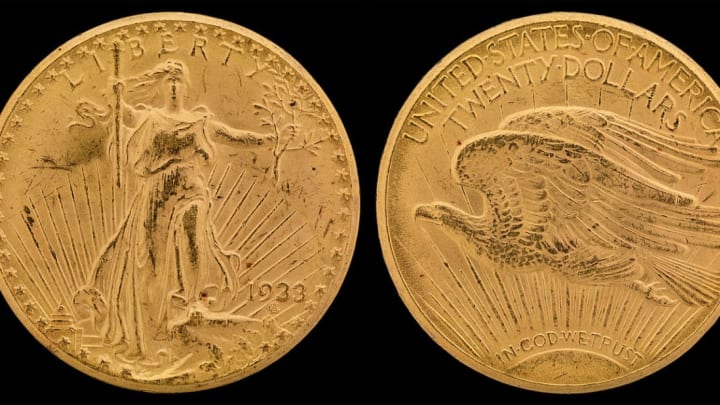Money as a concept is a strange one. Often, the materials used to make our cash—paper or metals—are worth a fraction of the value of what’s printed or embossed on their faces. But sometimes, thanks to rarity, historical happenstance, or minting or printing errors, our cash is worth more than its face value. Occasionally, a lot more—as in the case of the 10 most expensive coins and banknotes in the world.
10. 1891 US Red Seal $1,000 bill ($2.5 million)
The $1000 bill printed in 1891 depicting Major General George Gordon Meade on its face was sold for $2.5 million in April 2013, in part due to its rarity and age, and partly due to the hands it had passed through during history, making it one of the world’s most expensive banknotes ever sold.
9. 1913 Liberty Head nickel ($3.7 million)

The 1913 nickel was pressed without the approval of the U.S. Mint, which had switched the five-cent piece’s design from that of lady Liberty to the profile of a Native American. Only five managed to make their way into the public domain, the most expensive of which was bought for $3.7 million—though it’s believed that if one were found in mint condition, it could be worth $20 million alone.
8. 1804 Silver dollar, Class I ($3.8 million)

This 1804 silver dollar was not, in fact, minted in 1804. Rather, it was pressed 30 years later as a mix-up when minting dollars as gifts for Asian rulers on trade envoy visits. Sold by auctioneers Heritage Auctions, it garnered $3.7 million at auction in May 2008…
7. 1804 Silver dollar, Class I ($4.1 million)
…which is almost as much as a similar silver dollar from the same set of 15, sold by Bowers and Marena, which gained $4.1 million. In each case, for something actually worth a single dollar when pressed, the mark-up is impressive.
6. 2007 C$1m coin ($4.1 million)

A 100kg coin is, in and of itself, something of a rarity. But when you add on the fact that it was specially minted by the Royal Canadian Mint for the occasion, and that it is made of near pure (99.99 percent) gold, the $1 million face value of the coin gets inflated at auction to $4.1 million.
5. 1343 Edward III florin ($6.8 million)
Consider how many coins you lose behind the back of the sofa. Now consider how many coins you’d lose over 670 years. That’s precisely why the Edward III gold coin, minted in 1343, is so rare and valuable. It’s one of only three coins of its type known to have survived the centuries.
4. 1787 Brasher Doubloon ($7.4 million)

Ephraim Brasher was a talented goldsmith who petitioned New York State to mint a new set of coins in copper in 1787. But the state legislature didn’t want Brasher’s work, and didn’t want copper coins. Brasher ignored the state’s decision and went ahead minting coins anyway, mostly in bronze—but a precious few in 22-carat gold. One of these was a doubloon bought by a Wall Street investment firm for $7.4 million.
3. 1907 Saint-Gaudens double eagle ($7.6 million)

A complicated design produced by Augustus Saint-Gaudens proved too difficult for the U.S. Mint to make in commercial quantities, which led to the modification of the design. Rather than remove anything of Saint-Gaudens’ design, Charles Barber, the Mint’s chief engraver, chose to strike the words “In God We Trust” from the coin. Congress blew a gasket, and though the coin went through production, it’s now incredibly rare.
2. 1933 Double eagle ($7.6 million)

An example of a coin that has its value due to historical quirks of circumstance, the 1933 Double Eagle was pressed but never publicly released. Franklin D. Roosevelt barred anyone from owning gold in 1933 in an attempt to end the banking crisis wracking the U.S. at the time. Twenty slipped the net, though, and are worth far more than their $20 face value.
1. 1794/5 Flowing hair silver/copper dollar ($10 million)
When is a dollar coin worth $10 million? When it was the first dollar coin issued by the U.S. Federal Government. In 1794 and 1795 this 10 percent copper, 90 percent silver dollar was minted by the newly-founded U.S. Federal Mint, and its famous bust of Liberty with flowing tresses make it a historical memento worth far more than its face value. In January 2013, one 1794 dollar was sold for $10 million.
BONUS: 1875 Hide & Leather National $10 bill (???)
The Hide & Leather National Bank in Chicago only printed a smidgen over half a million dollars worth of bills in its 18 years of existence, which makes finding them—coupled with the time since their printing—extremely difficult. Auctioneers and collectors won’t put a price on the notes, but they’re worth substantially more than their $10 face value, even accounting for inflation.
